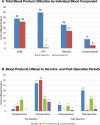Retrospective study assessing outcomes in cardiac surgery after implementation of Quantra
- PMID: 37069685
- PMCID: PMC10109219
- DOI: 10.1186/s13019-023-02245-x
Retrospective study assessing outcomes in cardiac surgery after implementation of Quantra
Abstract
Background: The Quantra QPlus System is a cartridge-based device with a unique ultrasound technology that can measure the viscoelastic properties of whole blood during coagulation. These viscoelastic properties correlate directly with hemostatic function. The primary objective of this study was to assess blood product utilization in cardiac surgery patients before and after the implementation of the Quantra QPlus System.
Methods: Yavapai Regional Medical Center implemented the Quantra QPlus System to aid in their efforts to reduce the transfusion of allogenic blood products and improve outcomes in patients undergoing cardiac surgery. A total of 64 patients were enrolled prior to the utilization of the Quantra (pre-Quantra cohort), and 64 patients were enrolled after (post-Quantra cohort). The pre-Quantra cohort had been managed via standard laboratory assays along with physician discretion for transfusion decisions. The utilization of blood products and frequency of transfusions were compared and analyzed between the two cohorts. (using the Student's t-test) RESULTS: The implementation of the Quantra resulted in a change in the pattern of blood product utilization leading to a demonstrated decrease in the amount of blood products transfused and the associated costs. The amount of FFP transfused was significantly decreased by 97% (P = 0.0004), whereas cryoprecipitate decreased by 67% (P = 0.3134), platelets decreased by 26% (P = 0.4879), and packed red blood cells decreased by 10% (P = 0.8027) however these trends did not reach statistical significance. The acquisition cost of blood products decreased by 41% for total savings of roughly $40,682.
Conclusions: Use of the Quantra QPlus System has the potential to improve patient blood management and decrease costs. STUDY REGISTERED AT CLINICALTRIALS.GOV: NCT05501730.
Keywords: Blood management; Cardiac surgery; Point-of-care testing, Quantra, Transfusion.
© 2023. The Author(s).
Conflict of interest statement
Pierre Tibi, MD. reports funding from HemoSonics LLC in the way of speakers fees.
Figures


Similar articles
-
Multicenter Evaluation of the Quantra QPlus System in Adult Patients Undergoing Major Surgical Procedures.Anesth Analg. 2020 Apr;130(4):899-909. doi: 10.1213/ANE.0000000000004659. Anesth Analg. 2020. PMID: 32032102
-
Comparison of the Quantra QPlus and ROTEM Goal-Directed Transfusion Protocols in Cardiothoracic Surgery Patients: A Prospective Observational Study.J Cardiothorac Vasc Anesth. 2024 Nov;38(11):2559-2566. doi: 10.1053/j.jvca.2024.07.046. Epub 2024 Aug 7. J Cardiothorac Vasc Anesth. 2024. PMID: 39256077
-
Comparison of the Quantra QPlus System With Thromboelastography in Cardiac Surgery.J Cardiothorac Vasc Anesth. 2021 Apr;35(4):1030-1036. doi: 10.1053/j.jvca.2020.11.058. Epub 2020 Dec 8. J Cardiothorac Vasc Anesth. 2021. PMID: 33384230
-
Roles of thrombelastography and thromboelastometry for patient blood management in cardiac surgery.Transfus Med Rev. 2013 Oct;27(4):213-20. doi: 10.1016/j.tmrv.2013.08.004. Epub 2013 Sep 26. Transfus Med Rev. 2013. PMID: 24075802 Review.
-
Point-of-care viscoelastic hemostatic testing in cardiac surgery patients: a systematic review and meta-analysis.Can J Anaesth. 2018 Dec;65(12):1333-1347. doi: 10.1007/s12630-018-1217-9. Epub 2018 Sep 7. Can J Anaesth. 2018. PMID: 30194674 English.
Cited by
-
Comment on Saner et al. The Yin and the Yang of Hemostasis in End-Stage Liver Disease. J. Clin. Med. 2023, 12, 5759.J Clin Med. 2024 Mar 14;13(6):1666. doi: 10.3390/jcm13061666. J Clin Med. 2024. PMID: 38541891 Free PMC article.
References
-
- Murphy GJ, Reeves BC et al. (2007). Increased mortality, postoperative morbidity, and cost after red blood cell transfusion in patients having cardiac surgery. Circulation. 2017; 116(22), 2544–2552. - PubMed
-
- Kozek-Langenecker S. Management of massive operative blood loss. Minerva Anesthesiol. 2007;73:401–15. - PubMed
-
- American Society of Anesthesiologists Task Force on Perioperative Blood Management Practice guidelines for perioperative blood management: an updated report by the American Society of Anesthesiologists Task Force on Perioperative Blood Management. Anesthesiology. 2015;122:241–75. doi: 10.1097/ALN.0000000000000463. - DOI - PubMed
MeSH terms
Associated data
LinkOut - more resources
Full Text Sources
Medical

